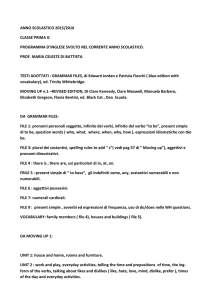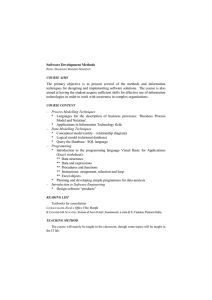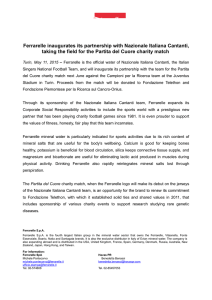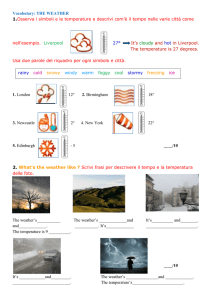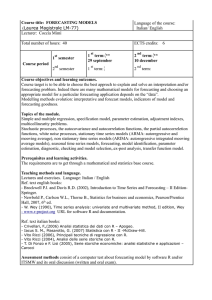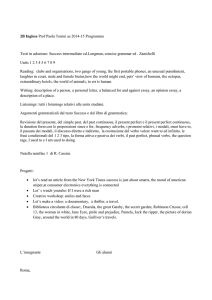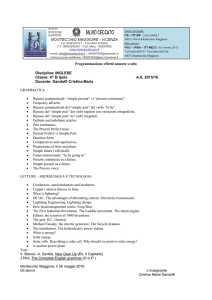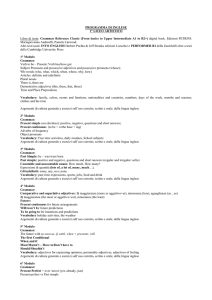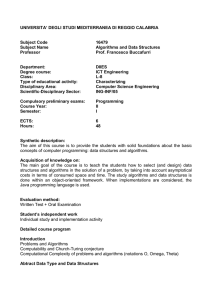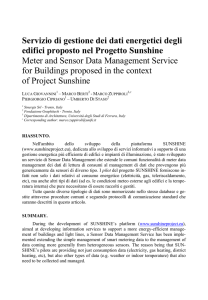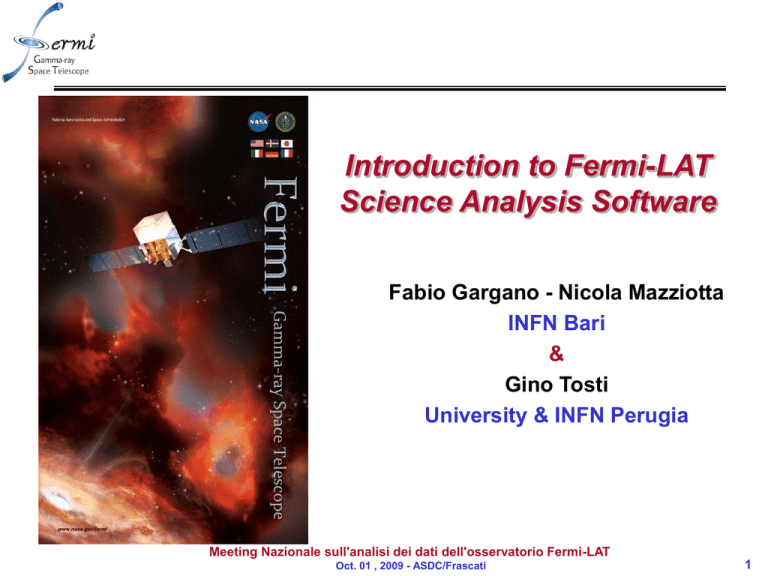
Introduction to Fermi-LAT
Science Analysis Software
Fabio Gargano - Nicola Mazziotta
INFN Bari
&
Gino Tosti
University & INFN Perugia
Meeting Nazionale sull'analisi dei dati dell'osservatorio Fermi-LAT
Oct. 01 , 2009 - ASDC/Frascati
1
REFERENCES
Fermi Science Support Center: http://fermi.gsfc.nasa.gov/ssc/
Fermi Newsletters: http://fermi.gsfc.nasa.gov/ssc/resources/newsletter/
Fermi Data Access: http://fermi.gsfc.nasa.gov/cgi-bin/ssc/LAT/LATDataQuery.cgi
Fermi Science Tools Reference Manual:
http://fermi.gsfc.nasa.gov/ssc/data/analysis/scitools/references.html
Fermi Analysis Threads:
http://fermi.gsfc.nasa.gov/ssc/data/analysis/scitools/
http://fermi.gsfc.nasa.gov/ssc/data/analysis/documentation/Cicerone/
Fermi - LAT Likelihood Algorithm description
http://fermi.gsfc.nasa.gov/ssc/data/analysis/documentation/Cicerone/Cicerone_Likelihood/
Cash W. 1979, ApJ 228, 939
Mattox J. R. et al 1996, ApJ 461, 396
Protassov et al. 2002, ApJ 57, 545
LAT Performance Page: http://www-glast.slac.stanford.edu/software/IS/glast_lat_performance.htm
The Large Area Telescope on the Fermi Gamma-Ray Space Telescope Mission, W.B. Atwood, et. al., ApJ, 2009, 695,
1071.
The On-orbit Calibrations for the Fermi Large Area Telescope, A.A. Abdo, et al. arXiv:0904.2226v1
Meeting Nazionale sull'analisi dei dati dell'osservatorio Fermi-LAT
Oct. 01 , 2009 - ASDC/Frascati
2
Fermi LAT Overview: Overall Design
Anticoincidence Detector:
Overall LAT Design:
•4x4 array of identical towers
•3000 kg, 650 W (allocation)
•1.8 m 1.8 m 1.0 m
•20 MeV – >300 GeV
• 89 scintillator tiles
• First step in reduction of large charged cosmic
ray background
• Segmentation reduces self veto at high energy
Thermal Blanket:
• And micro-meteorite shield
Precision Si-strip Tracker:
Measures incident gamma direction
18 XY tracking planes. 228 mm pitch.
High efficiency. Good position resolution
12 x 0.03 X0 front end => reduce multiple
scattering.
4 x 0.18 X0 back-end => increase
sensitivity >1GeV
Hodoscopic CsI Calorimeter:
• Segmented array of 1536 CsI(Tl) crystals
• 8.5 X0: shower max contained <100 GeV
• Measures the incident gamma energy
• Rejects cosmic ray backgrounds
e+
e–
Electronics System:
• Includes flexible, highly-efficient,
multi-level trigger
Meeting Nazionale sull'analisi dei dati dell'osservatorio Fermi-LAT
Oct. 01 , 2009 - ASDC/Frascati
3
Monitoring the Sky
•
In survey mode, the LAT observes the entire sky every two orbits (~3 hours), each
point on the sky receives ~30 mins exposure during this time.
•
The data are transmitted to the ground and the processed to obtain the high-Level
files available for the scientific analysis:
– event data file (FT1)
– spacecraft data file (FT2)
Meeting Nazionale sull'analisi dei dati dell'osservatorio Fermi-LAT
Oct. 01 , 2009 - ASDC/Frascati
4
Likelihood Analysis: Introduction
The final aim of any data analysis work is to derive the
best possible estimate for the characteristics of a source.
The Maximum Likelihood Analysis (MLA) has been
successfully used in the analysis of gamma-ray data and it
has also a central role in the LAT Data analysis.
The Fermi Science Analysis Software provides a tool to
perform:
•Unbinned
Maximum Likelihood Analysis
•Binned
Maximum Likelihood Analysis
Meeting Nazionale sull'analisi dei dati dell'osservatorio Fermi-LAT
Oct. 01 , 2009 - ASDC/Frascati
5
Source Model and Instrument Response
Meeting Nazionale sull'analisi dei dati dell'osservatorio Fermi-LAT
Oct. 01 , 2009 - ASDC/Frascati
6
Binned Likelihood
Meeting Nazionale sull'analisi dei dati dell'osservatorio Fermi-LAT
Oct. 01 , 2009 - ASDC/Frascati
7
Unbinned Likelihood
Nicola &sull'analisi
Fabio - ASDC
2009
Meeting Nazionale
dei Oct
dati 1-2,
dell'osservatorio
Fermi-LAT
Oct. 01 , 2009 - ASDC/Frascati
8
8
(Not) Handling Energy Dispersion
Nicola &sull'analisi
Fabio - ASDC
2009
Meeting Nazionale
dei Oct
dati 1-2,
dell'osservatorio
Fermi-LAT
Oct. 01 , 2009 - ASDC/Frascati
9
9
Diffuse sources
Nicola &sull'analisi
Fabio - ASDC
2009
Meeting Nazionale
dei Oct
dati 1-2,
dell'osservatorio
Fermi-LAT
Oct. 01 , 2009 - ASDC/Frascati
10
10
Installing the Fermi Science Tools
http://fermi.gsfc.nasa.gov/ssc/data/analysis/software/
•
You can install the Fermi Science Tools using either a source distribution or using a
precompiled binary. The preferred method is to use the binary distribution.
•
On a unix command line you can find your machine type with the command
– uname -m
and you should see something like i686, x86_64, or powerpc.
•
To determine the version of libc you can try
– ls /lib/libc-*
and you should see something like
– /lib/libc-2.3.4.so
where the 2.3.4 is the libc version.
•
Binary distributions are available for the following OS:
–
–
–
–
–
–
–
–
Scientific Linux 4.4 32 bit libc 2.3.4
Scientific Linux 5 32 bit libc 2.5
Scientific Linux 4 64 bit libc 2.3.4
Scientific Linux 5 64 bit libc 2.5
MAC OS X 10.4 powerpc
MAC OS X 10.4 intel
MAC OS X 10.5 powerpc
MAC OS X 10.5 intel
Meeting Nazionale sull'analisi dei dati dell'osservatorio Fermi-LAT
Oct. 01 , 2009 - ASDC/Frascati
11
Binary Install of the Fermi Science Tools
•
To install the Fermi Science Tools using the binary distribution,
please follow these steps:
1. Download the binaries for your system.
2. Unpack the distribution package in e.g. $HOME/glast
$ tar xzvf ScienceTools-v9r15p2-fssc-20090808<PLATFORM>.tar.gz
$cd ScienceTools-v9r15p2-fssc-20090808<PLATFORM>/<PLATFORM>/BUILD_DIR
3. Run the configure (e.g. in the bash shell):
$./configure >& configure.out
4. Set your FERMI_DIR environment variable to point to your
installation,
– $ export FERMI_DIR=$HOME/glast/ScienceTools-v9r15p2-fssc20090808-<PLATFORM>/i686-pc-linux-gnu-libc2.3.4
or:
$setenv FERMI_DIR $HOME/glast/ScienceTools-v9r15p2-fssc20090808-<PLATFORM>/i686-pc-linux-gnu-libc2.3.4
5. Execute the Fermi setup script:
– bash: $source $FERMI_DIR/fermi-init.sh
– csh: $source $FERMI_DIR/fermi-init.csh
Meeting Nazionale sull'analisi dei dati dell'osservatorio Fermi-LAT
Oct. 01 , 2009 - ASDC/Frascati
12
Overview
Meeting Nazionale sull'analisi dei dati dell'osservatorio Fermi-LAT
Oct. 01 , 2009 - ASDC/Frascati
13
IRF-PSF
Starting from the front of the instrument, the LAT tracker (TKR) has 12 layers of 3%
radiation length tungsten converters (THIN or FRONT section), followed by 4 layers of
18% r.l. tungsten converters (THICK or BACK section). These sections have
intrinsically different PSF due to multiple scattering,
http://www-glast.slac.stanford.edu/software/IS/glast_lat_performance.htm
The LAT IRFs are included in the ST
Meeting Nazionale sull'analisi dei dati dell'osservatorio Fermi-LAT
Oct. 01 , 2009 - ASDC/Frascati
14
IRF-Effective Area - Energy Disperision
http://www-glast.slac.stanford.edu/software/IS/glast_lat_performance.htm
Meeting Nazionale sull'analisi dei dati dell'osservatorio Fermi-LAT
Oct. 01 , 2009 - ASDC/Frascati
15
Diffuse Models
http://fermi.gsfc.nasa.gov/ssc/data/access/lat/ring_for_FSSC_final4.pdf
Meeting Nazionale sull'analisi dei dati dell'osservatorio Fermi-LAT
Oct. 01 , 2009 - ASDC/Frascati
16
Point Source Analysis
To start a point source analysis you have to fix:
1.
2.
3.
4.
5.
6.
7.
Region of Interest (ROI) center (RA, DEC)
ROI Radius
Start Time (MET)
Stop Time (MET)
Minimum Energy
Maximum Energy
Event Class to Use (Transient, Source, Diffuse)
Meeting Nazionale sull'analisi dei dati dell'osservatorio Fermi-LAT
Oct. 01 , 2009 - ASDC/Frascati
17
Source Region and ROI
Due to the large LAT point spread function at low energies (e.g., 68% of the counts
will be within 3.5 degrees at 100 MeV, see http://wwwglast.slac.stanford.edu/software/IS/glast_lat_performance.htm for a review of LAT
performance), to analyze a single source the counts within a region around the
source have to be included.
We call that region the "region of interest" (ROI). The ROI is selected from the
original event file using the gtselect tool.
The ROI should be several times the characteristic PSF size in order to satisfy the
restrictions of the Likelihood package.
Nearby sources will contribute counts to that region, so they have to be model as
well. The region that includes that sources is called "Source Region". All these
sources will be in the source model file that has to be input in gtlike.
The "Source Region" is centered on the ROI, with a radius that is larger than the
ROI radius by several PSF length scales. For example, when fitting a single point
source, a ROI with a radius of 10 degrees and a Source Region radius of 20 degrees
would be appropriate. Note that since the size of the LAT PSF goes roughly as
(PSF_100MeV) x (E/100)^{-0.8} (with E in MeV), if you are considering only higher
energy photons, e.g., > 1 GeV, smaller ROI and Source Region radii of just a few
degrees may be used.
Meeting Nazionale sull'analisi dei dati dell'osservatorio Fermi-LAT
Oct. 01 , 2009 - ASDC/Frascati
18
The Point Source Analysis Diagram
Region Selection
gtselect, gtmktime
gtvcut
DATA (FT1-FT2)
Diffuse Rensponse
gtdiffrsp
Binning/MAP/LC
(gtbin)
Source Model
definition
ModelEditor
Exposure
gtltcube
gtexpmap
Likelihood
gtlike
Results
Meeting Nazionale sull'analisi dei dati dell'osservatorio Fermi-LAT
Oct. 01 , 2009 - ASDC/Frascati
19
Data Access
ftp download: ftp://legacy.gsfc.nasa.gov/fermi/data/lat/weekly/
Meeting Nazionale sull'analisi dei dati dell'osservatorio Fermi-LAT
Oct. 01 , 2009 - ASDC/Frascati
20
INPUT DATA
• The photon FT1 fits FT1 file:
– L090923112502E0D2F37E71_PH00.fits
• and the pointing and livetime history FT2 files.
– L090923112502E0D2F37E71_SC00.fits
Meeting Nazionale sull'analisi dei dati dell'osservatorio Fermi-LAT
Oct. 01 , 2009 - ASDC/Frascati
21
Step 1-Event Selection
$$$> gtselect evclsmax=3 evclsmin=3
Input FT1 file [] : L090923112502E0D2F37E71_PH00.fits
Output FT1 file [] : myROI_filtered.fits
RA for new search center (degrees) (0:360) [0] : 343.490616
Dec for new search center (degrees) (-90:90) [0] : 16.148211
radius of new search region (degrees) (0:180) [180] : 10
start time (MET in s) (0:) [0] : 266976000
end time (MET in s) (0:) [0] : 275369897
lower energy limit (MeV) (0:) [30] : 100
upper energy limit (MeV) (0:) [300000] : 300000
maximum zenith angle value (degrees) (0:180) [180]: 105
Scriptable form of the command:
gtselect infile= L090923112502E0D2F37E71_PH00.fits outfile=3c279_filtered.fits
ra=193.98 dec=-5.82 rad=15 tmin=266976000 tmax= 275369897 emin=100
emax=100000 zmax=105 evclsmax=3 evclsmin=3
Meeting Nazionale sull'analisi dei dati dell'osservatorio Fermi-LAT
Oct. 01 , 2009 - ASDC/Frascati
22
Step 1-Time Selection
$$$> gtmktime
Spacecraft data file [] L090923112502E0D2F37E71_SC00.fits
Filter expression [IN_SAA!=T] IN_SAA!=T && DATA_QUAL==1
Apply ROI-based zenith angle cut[yes] : yes
Event data file [] : myROI_filtered.fits
Output event file name [] : myROI_filtered_time.fits
Scriptable form of the command:
gtmktime scfile= L090923112502E0D2F37E71_SC00.fits filter= IN_SAA!=T && DATA_QUAL==1 roicut=yes
Evfile= myROI_filtered.fits
outfile= myROI_filtered_time.fits
Meeting Nazionale sull'analisi dei dati dell'osservatorio Fermi-LAT
Oct. 01 , 2009 - ASDC/Frascati
23
Step 2: Counts Map
$$$> gtbin
This is gtbin version ScienceTools-v9r15p2-fssc-20090808
Type of output file (CCUBE|CMAP|LC|PHA1|PHA2) [PHA2] CMAP
Event data file name[] myROI_filtered.fits
Output file name[] myROIcounts_map.fits
Spacecraft data file name[NONE]
Size of the X axis in pixels[] 80
Size of the Y axis in pixels[] 80
Image scale (in degrees/pixel)[] 0.25
Coordinate system (CEL - celestial, GAL -galactic) (CEL|GAL) [CEL]
First coordinate of image center in degrees (RA or galactic l)[] 343.490616
Second coordinate of image center in degrees (DEC or galactic b)[]16.148211
Rotation angle of image axis, in degrees[0.]
Projection method e.g. AIT|ARC|CAR|GLS|MER|NCP|SIN|STG|TAN:[AIT]
Scriptable form of the command:
gtbin evfile=events_filtered.fits scfile=NONE outfile=counts_map.fits
algorithm=CMAP nxpix=120 nypix=120 binsz=0.25 coordsys=CEL xref=343.49 yref=16.14
axisrot=0 proj=AIT
Meeting Nazionale sull'analisi dei dati dell'osservatorio Fermi-LAT
Oct. 01 , 2009 - ASDC/Frascati
24
Step 2-Counts Map
Meeting Nazionale sull'analisi dei dati dell'osservatorio Fermi-LAT
Oct. 01 , 2009 - ASDC/Frascati
25
Step 3:The Source Model
http://fermi.gsfc.nasa.gov/ssc/data/analysis/scitools/xml_model_defs.html#xmlModelDefinitions
Source Region
ROI
Nearby sources will contribute counts to
that region, so they have to be model as
well. The region that includes that
sources is called
"Source Region". All these sources will
be in the source model file that has to be
input in gtlike
The "Source Region" is centered on the
ROI, with a radius that is larger than the
ROI radius by several PSF length
scales.
Meeting Nazionale sull'analisi dei dati dell'osservatorio Fermi-LAT
Oct. 01 , 2009 - ASDC/Frascati
26
Step 3:The Source Model
http://fermi.gsfc.nasa.gov/ssc/data/analysis/scitools/xml_model_defs.html#xmlModelDefinitions
$$$>modeleditor
Meeting Nazionale sull'analisi dei dati dell'osservatorio Fermi-LAT
Oct. 01 , 2009 - ASDC/Frascati
27
Step 4-Livetimes
$$$> gtltcube
Event data file [] : myROI_filtered_time.fits
Spacecraft data file [test_scData_0000.fits] : L090923112502E0D2F37E71_SC00.fits
Output file [expCube.fits] : expCube.fits
Step size in cos(theta) <0. - 1.> [0.025] : 0.025
Pixel size (degrees) [1] :
More info on the Sky pixelization used by gtlivetimecube can be found here HEALPix (http://healpix.jpl.nasa.gov/)
To add two livetimeCube you can use:
$$$>gtltsum
Livetime cube 1 or list of files [expCube_00.fits] : expCube0.fits
Livetime cube 2 [expCube_01.fits] : expCube1.fits
Output file [expCube.fits] : expcube_01.fits
Scriptable form of the command:
gtltcube evfile= myROI_filtered_time.fits scfile=L090923112502E0D2F37E71_SC00.fits
outfile=expCube.fits dcostheta=0.025 binsz=1
Meeting Nazionale sull'analisi dei dati dell'osservatorio Fermi-LAT
Oct. 01 , 2009 - ASDC/Frascati
28
(Step 5-Diffuse Source Responses)
$$$> gtdiffrsp
Event data file [test_events_0000.fits] : myROI_filtered_time.fits
Spacecraft data file [] : L090923112502E0D2F37E71_SC00.fits
Source model file [my_source_model.xml] : mymodel.xml
Response functions to use [DC2] :P6_V3_DIFFUSE
This step is not necessary for the FT1 file provided by FSSC already has
pre-computed diffuse response columns!!!
Meeting Nazionale sull'analisi dei dati dell'osservatorio Fermi-LAT
Oct. 01 , 2009 - ASDC/Frascati
29
Step 5-Exposure Map
$$$> gtexpmap
Event data file [test_events_0000.fits] : myROI_filtered_time.fits
Spacecraft data file [test_scData_0000.fits] : L090923112502E0D2F37E71_SC00.fits
Exposure hypercube file [expCube.fits] : expCube.fits
output file name [expMap.fits] : expMap.fits
Response functions [DC2] : P6_V3_DIFFUSE
Radius of the source region (in degrees) [30] :15
Number of longitude points <2 - 1000> [120] :120
Number of latitude points <2 - 1000> [120] : 120
Number of energies <2 - 100> [20] : 20
Scriptable form of the command:
gtexpmap evfile= myROI_filtered_time.fits scfile=
L090923112502E0D2F37E71_SC00.fits
expcube= expCube.fits outfile=expMap.fits irfs=P6_V3_DIFFUSE
srcrad=15 nlong=120 nlat=120 nenergies=20
Meeting Nazionale sull'analisi dei dati dell'osservatorio Fermi-LAT
Oct. 01 , 2009 - ASDC/Frascati
30
gtlike
The gtlike tool performs unbinned and binned likelihood analysis of the LAT data.
The likelihood statistic L is the probability of obtaining observational data given an
input model. In our case, the input model is the distribution of gamma-ray sources on
the sky, and includes their intensity and spectra.
We use this statistic to find the best fit model parameters. These parameters include
the description of a source's spectrum, its position, and intensity
The data will be too sparse in many cases to allow the use of CHI2 as test statistic. In
that case, a full Poisson likelihood optimization is needed for model parameter
estimation.
For a small number of counts the unbinned likelihood can be calculated rapidly, but
as the number of counts increases the time to calculate the likelihood becomes
prohibitive, and the binned likelihood must be used.
Like in EGRET we use the Test Statistics (TS) to establish the significance of the
detection of a source. The TS value is defined as:
TS = 2 (logL-logL0)
(L0 is the likelihood value for the null hypothesis)
Meeting Nazionale sull'analisi dei dati dell'osservatorio Fermi-LAT
Oct. 01 , 2009 - ASDC/Frascati
31
gtlike
http://fermi.gsfc.nasa.gov/ssc/data/analysis/scitools/python_tutorial.html
$$$ python
Python 2.5.1 (r251:54863, Aug 8 2009, 12:04:48)
[GCC 4.0.1 (Apple Inc. build 5465)] on darwin
Type "help", "copyright", "credits" or "license" for more information.
>>> import pyLikelihood
>>> from UnbinnedAnalysis import *
>>> my_obs = UnbinnedObs('events_diffuse_filtered_gti.fits', 'spacecraft_data_file.fits',
expMap='expMap.fits', expCube='expCube.fits', irfs='P6_V3_DIFFUSE')
>>> analysis = UnbinnedAnalysis(my_obs, 'src_model.xml', optimizer='NewMinuit')
>>> analysis.plot()
>>> like.fit(verbosity=0)
>>> like.oplot()
Meeting Nazionale sull'analisi dei dati dell'osservatorio Fermi-LAT
Oct. 01 , 2009 - ASDC/Frascati
32
Step 7: Unbinned Likelihood
$$$> gtlike
Statistic to use <BINNED|UNBINNED> [UNBINNED] :
Spacecraft file [] : myROI_filtered_time.fits
Event file [] : L090923112502E0D2F37E71_SC00.fits
Unbinned exposure map [LAT_tut_expMap.fits] : expMap.fits
Exposure hypercube file [LAT_tut_expCube.fits] : expCube.fits
Source model file [ac_source_model.xml] : mymodel.xml
Response functions to use [DC2] :
Optimizer] (DRMNFB|NEWMINUIT|MINUIT|DRMNGB|LBFGS) [DRMNFB]: MINUIT
The results are stored in the file: result.dat
Scriptable form of the command:
gtlike irfs=P6_V3_DIFFUSE expcube=expCube.fits
srcmdl=mymodel.xml statistic=UNBINNED optimizer=MINUIT
evfile= myROI_filtered_time.fits scfile= L090923112502E0D2F37E71_SC00.fits
expmap=expMap.fits
Meeting Nazionale sull'analisi dei dati dell'osservatorio Fermi-LAT
Oct. 01 , 2009 - ASDC/Frascati
33
Step 7: Unbinned Likelihood
Results
http://fermi.gsfc.nasa.gov/ssc/data/analysis/scitools/likelihood_tutorial.html
Meeting Nazionale sull'analisi dei dati dell'osservatorio Fermi-LAT
Oct. 01 , 2009 - ASDC/Frascati
34
CAVEAT and systematics
http://fermi.gsfc.nasa.gov/ssc/data/analysis/LAT_caveats.html
• Use "Diffuse" class for diffuse, extended, and point source analysis.
• Data below 100 MeV can not be used for spectral analysis
• Data above 10 GeV currently have non-negligible background contamination from
charged particles.
• Given the current limited statistics at hundreds of GeV, we recommend limiting spectral
analysis to energies smaller than 300 GeV.
• Systematics: 10% at 100 MeV, decreasing to 5% at 560 MeV, and increasing to 20% at
10 GeV and above
• At energies >32 GeV the width of the PSF may be underestimated by a factor of ~2.
• The absolute LAT energy scale, at this early stage of the mission, is determined with an
uncertainty of +5% -10%.
Meeting Nazionale sull'analisi dei dati dell'osservatorio Fermi-LAT
Oct. 01 , 2009 - ASDC/Frascati
35
Conclusion
To analyze the time & spectral variations of a source you have to run iteratively
the likelihood tool, using procedures similar to the following
• Step 1 - Download data for your ROI from the DATA server over the
entire time interval (T) where you want to study variability;
• Step 2 - Build a Source Model for your ROI
• Step 3 - Divide T in N time bins, and for each bin obtain a FT1 file with
gtselect/gtmktime;
• Step 4 - Compute the livetimecube (gtltcube) for each time
• Step 5 - Calculate the ExposureMap (gtexpmap)
• Step 6 - Run gtlike and rename the output result file
Repeat steps 4-6 for each time bin……write a script to do this work……
Meeting Nazionale sull'analisi dei dati dell'osservatorio Fermi-LAT
Oct. 01 , 2009 - ASDC/Frascati
36

